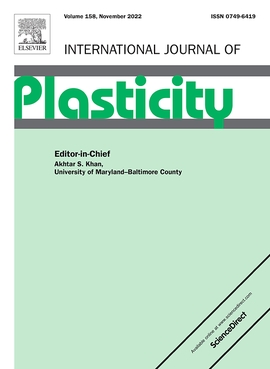
An aquifer is an underground layer of water-bearing material, consisting of permeable or fractured rock, or of unconsolidated materials. Aquifers vary greatly in their characteristics. The study of water flow in aquifers and the characterization of aquifers is called hydrogeology. Related terms include aquitard, which is a bed of low permeability along an aquifer, and aquiclude, which is a solid, impermeable area underlying or overlying an aquifer, the pressure of which could lead to the formation of a confined aquifer. The classification of aquifers is as follows: Saturated versus unsaturated; aquifers versus aquitards; confined versus unconfined; isotropic versus anisotropic; porous, karst, or fractured; transboundary aquifer.

Ductility refers to the ability of a material to sustain significant plastic deformation before fracture. Plastic deformation is the permanent distortion of a material under applied stress, as opposed to elastic deformation, which is reversible upon removing the stress. Ductility is a critical mechanical performance indicator, particularly in applications that require materials to bend, stretch, or deform in other ways without breaking. The extent of ductility can be quantitatively assessed using the percent elongation at break, given by the equation:

Fracture is the appearance of a crack or complete separation of an object or material into two or more pieces under the action of stress. The fracture of a solid usually occurs due to the development of certain displacement discontinuity surfaces within the solid. If a displacement develops perpendicular to the surface, it is called a normal tensile crack or simply a crack; if a displacement develops tangentially, it is called a shear crack, slip band, or dislocation.

In materials science, fatigue is the initiation and propagation of cracks in a material due to cyclic loading. Once a fatigue crack has initiated, it grows a small amount with each loading cycle, typically producing striations on some parts of the fracture surface. The crack will continue to grow until it reaches a critical size, which occurs when the stress intensity factor of the crack exceeds the fracture toughness of the material, producing rapid propagation and typically complete fracture of the structure.
Springer Science+Business Media, commonly known as Springer, is a German multinational publishing company of books, e-books and peer-reviewed journals in science, humanities, technical and medical (STM) publishing.

In materials science, the Charpy impact test, also known as the Charpy V-notch test, is a standardized high strain rate test which determines the amount of energy absorbed by a material during fracture. Absorbed energy is a measure of the material's notch toughness. It is widely used in industry, since it is easy to prepare and conduct and results can be obtained quickly and cheaply. A disadvantage is that some results are only comparative. The test was pivotal in understanding the fracture problems of ships during World War II.
Applied mechanics is the branch of science concerned with the motion of any substance that can be experienced or perceived by humans without the help of instruments. In short, when mechanics concepts surpass being theoretical and are applied and executed, general mechanics becomes applied mechanics. It is this stark difference that makes applied mechanics an essential understanding for practical everyday life. It has numerous applications in a wide variety of fields and disciplines, including but not limited to structural engineering, astronomy, oceanography, meteorology, hydraulics, mechanical engineering, aerospace engineering, nanotechnology, structural design, earthquake engineering, fluid dynamics, planetary sciences, and other life sciences. Connecting research between numerous disciplines, applied mechanics plays an important role in both science and engineering.
The Archive of Applied Mechanics is a peer-reviewed scientific journal established in 1929 as Ingenieur-Archiv by R. Grammel. It obtained its current name in 1991 and is published by Springer. The journal covers research findings on the performance of construction materials. The editor in chief is Jörg Schröder.
Palle Rama Rao FREng is an Indian scientist noted for his contribution to the field of Physical and Mechanical Metallurgy. He has collaborated and conducted research activities for over dozen universities and associations all over India and abroad. He has been honoured with the titles of Padma Vibhushan in 2011 by president of India for his contributions to scientific community. He is acting as the chairman, Governing Council, International Advanced Research Centre for Powder Metallurgy & New Materials (ARCI), Hyderabad.
Zhigang Suo is the Allen E. and Marilyn M. Puckett Professor of Mechanics and Materials in the Harvard School of Engineering and Applied Sciences. His research centers on the mechanical behavior of materials and structures.

Bhagavatula Dattaguru is an Indian engineer and academic. He has received several awards, including the Padma Shri Award, India's fourth highest civilian honour in 2005 in the field of science and engineering.

Society for Experimental Mechanics (SEM) is a professional organization for engineers and scientists studying the design and implementation of experiments to characterize materials, structures, and systems. Formed in 1943 as the Society for Experimental Stress Analysis (SESA), early work focused on methods such as photoelasticity and strain gages. Society historical records refer to the society as SESA through the 1984 Fall SESA meeting in Milwaukee, WI and start referring the society as SEM with the 1985 Spring SEM meeting in Las Vegas, NV. The society has expanded to include topics including modal analysis, digital image correlation, Split Hopkinson pressure bar, Residual stress, and biomaterials.
Ramarathnam Narasimhan is an Indian materials engineer and a professor at the Department of Mechanical Engineering of the Indian Institute of Science. He is known for his pioneering researches on fracture mechanics and is an elected fellow of the Indian Academy of Sciences, Indian National Science Academy and the Indian National Academy of Engineering. The Council of Scientific and Industrial Research, the apex agency of the Government of India for scientific research, awarded him the Shanti Swarup Bhatnagar Prize for Science and Technology, one of the highest Indian science awards for his contributions to Engineering Sciences in 1999.

Geо́rge Antо́novych Gogо́tsi is a soviet Ukrainian scientist, professor of solid mechanics, doctor of science, and leading researcher of the Pisarenko Institute for Problems of Strength of the National Academy of Sciences of Ukraine.

Emmanuel E. Gdoutos is a Greek academic, Professor Emeritus at the Democritus University of Thrace and Full Member of the Academy of Athens. He has worked in experimental mechanics, fracture mechanics, composite materials, and sandwich structures. His main scientific accomplishments include the solution of many problems of crack growth under combination of opening-mode and sliding-mode loading which were published in his book: “Problems of Mixed-Mode Crack Propagation." His contributions have been widely recognized worldwide through membership and leadership in scientific societies, national academies and honorary diplomas and awards.

The International Journal of Fatigue is a monthly peer-reviewed scientific journal covering research, theory, and practice concerning the fatigue of materials and structures. The journal is published by Elsevier in affiliation with the European Structural Integrity Society. As of October 2022, the editors-in-chief are Guozheng Kang, Michael D. Sangid, and Michael Vormwald.

The International Journal of Plasticity is a monthly peer-reviewed scientific journal that covers research that relates to micro and macro plastic deformation and fracture for isotropic and anisotropic materials.The journal is published by Elsevier and the editors-in-chief is Akhtar S. Khan.











